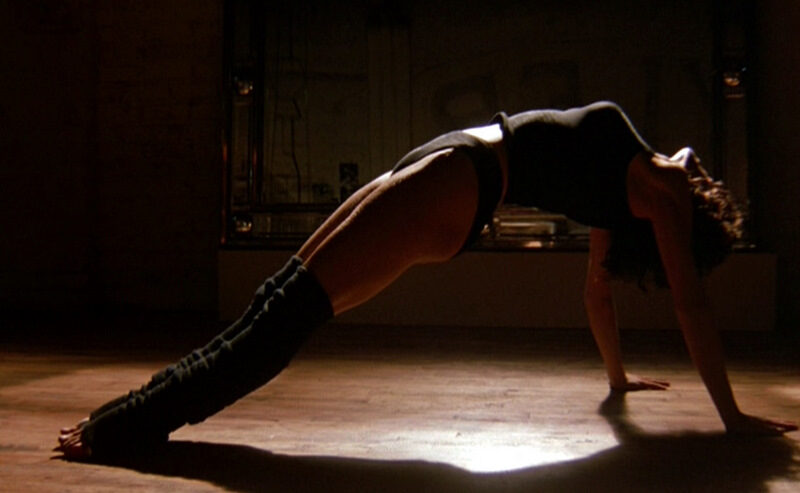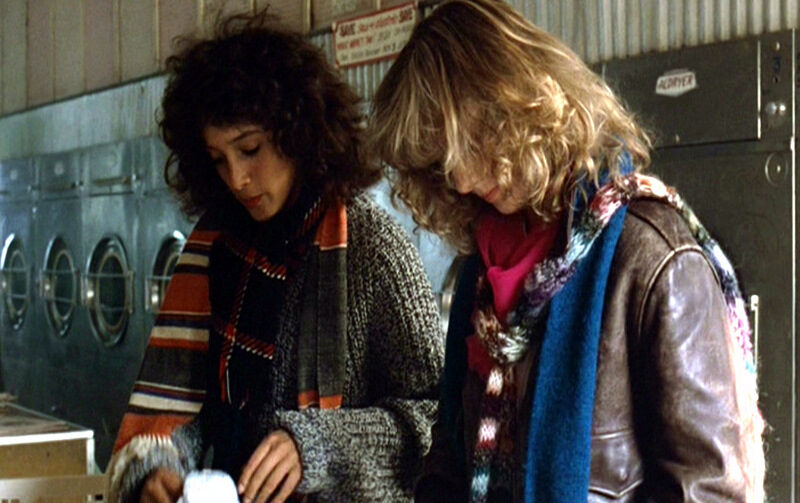Flashdance: Jennifer Beals’ Dance & Casual Wear |
 © 2009, Clothes on Film 31 Jul ’09
© 2009, Clothes on Film 31 Jul ’09
Though really nothing more than an extended, backlit music promo, Flashdance (1983, directed by Adrian Lyne) has garnered a considerable cult following in recent years.
Savaged by poor reviews on its release, the film is now embraced as a musical and stylistic record of the second most hedonistic decade in western history. In this respect it is actually a stronger movie than, say, Wall Street (1986), and Flashdance even has a biracial woman as its star; unusual at the time, we should perhaps be grateful producers Don Simpson and Jerry Bruckheimer didn’t opt for Goldie Hawn instead.
The clothing in Flashdance can be separated into two categories: dance wear and masculine inspired formal/casual wear.
As feisty dreamer Alex, Jennifer Beals wears a slashed neck graffiti print t-shirt, ripped sweater, Lycra keep-fitters, torn jeans, cropped vests and pushed-down leggings for dance or slouch dress. Out and about in chilly Pennsylvania she chooses a heavy topcoat, oversized jumpers, several scarves worn at once, wide man-styled jackets (all with plentiful layering), leggings, skinny trousers, thick-soled boots, a red military dress coat, even a green army jacket with insignia patches.
Also, in a moment of Diane Keaton-like retrospection, Alex dons a man’s tuxedo for her meal at a fancy restaurant. No shirt however, just black jacket and trousers, bib, cuff and wing collar. Undoubtedly added by Lyne and costume designer Michael Kaplan (Fight Club, Star Trek ’09) to shock the audience, this takes the exploitation of her latent femininity too far. It veers into parody and doesn’t convince.
Arguably Beals’ most famous outfit was a simple raglan sleeve sweatshirt in grey fleece cotton. Worn ripped and hanging salaciously off the shoulder, Beals claims the idea for this look came from accidentally shrinking her sweater and then removing the collar to fit it over her head. Michael Kaplan maintains the concept originated from watching actual dancers (no disrespect to Beals) keeping their muscles warm in baggy clothes they had customised for ease of movement.
Regardless of the sweater’s actual history however, Flashdance did precipitate an enduring look. Although it should be noted that fleecy casual wear was not invented for the movie; certain couture designers had been exploiting the fabric since the late 1970s and their styles had already been reinterpreted for the high street (paradoxically where most took inspiration from in the first place).
In 1980, New York designer Norma Kamali produced an entire line in fleece jersey. This was the first time the sporting fabric had been used on the catwalk, though by mid-decade it had rocketed into the mainstream with cotton accounting for nearly half of the world’s textile production. For another filmic example see Risky Business (1983). Again the emphasis is masculine tinged as Rebecca De Mornay parades around in front of Tom Cruise wearing nothing but his grey college sweater and a smile.
Besides Kamali another couture name to influence the look of Flashdance was UK design team Stevie Stewart and David Holah, aka ‘Bodymap’. Known for their figure-wrapping style and details such as scooped necklines and gaping holes in unusual places, Bodymap led a revolution in the way fashion came to present the human form. Likewise in 1982 Rei Kawakubo founder of Comme des Garçons had introduced a ‘holey’ sweater along a similar vein. Jean-Paul Gaultier (mid-80′s) and later Alexander McQueen (mid-90′s) developed this approach even further with their own radical creations.
While in dance mode Jennifer Beals wears copious amounts of tight and stretchy Lycra. The 1980s was a colourful boom time for this synthetic fibre brand, though the shades used in Flashdance were, in hindsight, surprisingly muted. A very high-leg black leotard and mid-blue leggings for example. By the early 1990s, colours would grow ever more lurid as lime green and florescent pink variations hit their peak in popularity.
For casual wear, Kaplan inferred Alex as struggling to exist in a male dominated world; by adopting a mannish style of dress she was hoping to fit in. The army jacket originally took off after WW2 when military surplus flooded the market, though women really only started wearing them in the 1970s. Combat appliqué (badges, epaulettes) was a burgeoning trend in 1983.
The wide-ribbed marl knitwear Alex wears away from the steel mill was clearly informed by Giorgio Armani’s output during at the time. This deluxe Italian style is echoed by her boyfriend, rich mill owner Nick (Michael Nouri); his luxury leather blouson, tweed jacket, and fine knitted sweatshirts were fast becoming an Armani staple and have since been recognised as the designer’s signature look.
Despite that poster image sweater being considered the most famous look from Flashdance, Alex’s chunky knits (especially in cardigan form) are perhaps even more enduring today. Although fads do come and go, as her penchant for wearing four scarves at once demonstrates; by the time you are reading this, whenever you are reading this, you may well be doing so in a purposely ripped grey t-shirt.
Just take a peep at Topshop for further proof of the legacy of Flashdance. The film practically serves as an advert for their entire rollover collection.
© 2009 – 2012, Chris Laverty.









